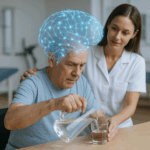KNEE PAIN: UNDERSTANDING THE ANATOMY, CAUSES, AND TREATMENTS
The knee is a complex joint that plays a crucial role in supporting and enabling movement in the body. Pain in the knee can have a significant impact on daily activities and quality of life. To help understand and manage knee pain, it’s important to understand the anatomy, biomechanics, causes, and treatments involved.
ANATOMY OF THE KNEE
The knee joint is a hinge joint that connects the thigh bone (femur) to the shin bone (tibia). The knee also has two smaller bones, the fibula, and the patella (kneecap). These bones are connected by strong ligaments and surrounded by tendons and muscles. The knee joint is cushioned by two types of cartilage: the articular cartilage that covers the joint surfaces and the meniscus, which acts as a shock absorber.
BIOMECHANICS OF THE KNEE
The knee joint is designed to provide stability and support while also allowing for a wide range of movements, such as bending and straightening. The muscles and tendons surrounding the knee joint work together to control its movements and maintain proper alignment. When these muscles and tendons are imbalanced or weakened, it can lead to knee pain and instability.
CAUSES OF KNEE PAIN
There are many possible causes of knee pain, including:
Arthritis: Inflammation of the knee joint, causing pain and stiffness
Tendinitis: Inflammation of the tendons surrounding the knee
Bursitis: Inflammation of the bursae (small fluid-filled sacs) around the knee
Fractures: A broken bone in the knee
Dislocated knee: A dislocation occurs when the bones in the knee are out of alignment
Torn ligaments: Tears in the ligaments supporting the knee, such as the ACL (anterior cruciate ligament) or MCL (medial collateral ligament)
Meniscus tear: A tear in the cartilage that cushions the knee joint
Patellofemoral pain syndrome: Pain in the front of the knee, caused by wear and tear on the knee cap and its surrounding tissues.
PREVENTION TIPS
To reduce the risk of knee pain and injuries, consider incorporating these tips into your daily routine:
· Maintain a healthy weight to reduce stress on the knee joint
· Strengthen the muscles surrounding the knee, such as the quadriceps and hamstrings, through regular exercise
· Incorporate low-impact activities, such as swimming and cycling, into your workout routine
· Wear appropriate shoes and support for your feet and knees
· Avoid high-impact activities and sudden changes in direction, especially if you have a history of knee problems.
TREATMENT FOR KNEE PAIN
Treatment for knee pain depends on the cause and severity of the pain. In many cases, a combination of physiotherapy and manual therapy can help alleviate knee pain and promote healing. If you are experiencing knee pain, there are a variety of treatments that can help to relieve pain and improve joint function. These treatments include:
Physiotherapy and Manual Therapy: These treatments can help to improve joint mobility and reduce pain.
Myofascial Releases: This type of therapy involves releasing tight or restricted fascia, which can be causing pain and limiting joint mobility.
Muscle Energy Technique: This type of therapy involves using the muscles to help restore joint mobility and reduce pain.
Proprioceptive Exercises: These exercises are designed to improve balance and coordination, helping to reduce knee pain.
Strengthening Exercises: These exercises are designed to improve the strength and stability of the muscles around the knee, helping to reduce pain and prevent injury.
Laser Therapy: This type of therapy involves using low-level laser light to reduce pain and inflammation.
Electromodalities: This type of therapy involves the use of electrical stimulation to reduce pain and improve joint function.
Knee pain is a common condition that can be caused by a variety of factors, including injury, overuse, and underlying medical conditions. Understanding the anatomy and biomechanics of the knee can help to identify the root cause of the pain and develop an effective treatment plan.
Physical therapy and manual therapy techniques, such as myofascial releases, muscle energy techniques, and proprioceptive exercises, can help to reduce pain, improve range of motion, and strengthen the knee joint. Other treatment options, such as laser therapy and electrotherapy modalities, can also be effective in reducing pain and promoting healing.
In addition to seeking professional treatment, there are several preventative measures that individuals can take to reduce the risk of knee pain. This includes maintaining a healthy weight, practicing proper form during physical activity, and wearing appropriate footwear to support the knee joint.
If you are experiencing knee pain, it is important to seek the advice of a medical professional to determine the underlying cause and develop an effective treatment plan. With the right combination of therapeutic techniques, exercise, and lifestyle modifications, it is possible to reduce pain and improve the function of the knee joint.







